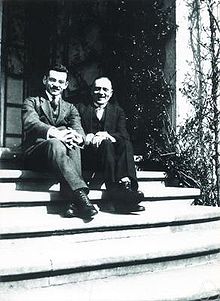- Otto Toeplitz
-
 Otto Toeplitz and Alexander Ostrowski.
Otto Toeplitz and Alexander Ostrowski.
Otto Toeplitz (1 August 1881, Breslau – 15 February 1940, Jerusalem) was a German Jewish mathematician working in functional analysis.
Contents
Life and work
Toeplitz's father and grandfather were mathematics teachers. Toeplitz studied mathematics in the University of Breslau and was awarded a doctorate in algebraic geometry in 1905. In 1906 Toeplitz arrived to Göttingen University, which was then the world's leading mathematical center, and he remained there for seven years. Mathematics faculty included David Hilbert, Felix Klein, and Hermann Minkowski. Toeplitz joined a group of young people working with Hilbert: Max Born, Richard Courant and Ernst Hellinger, with whom he collaborated for many years afterward. At that time Toeplitz began to rework the theory of linear functionals and quadratic forms on n-dimensional spaces for infinite dimensional spaces. He wrote five papers directly related to spectral theory of operators which Hilbert was developing. During this period he also published a paper on summation processes and discovered the basic ideas of what are now called the Toeplitz operators. In 1913 Toeplitz became an extraordinary professor at the University of Kiel. He was promoted to a professor in 1920.
In 1911, Toeplitz proposed the inscribed square problem:
- Does every Jordan curve contain an inscribed square?
This has been established for convex curves and smooth curves, but the question remains open in general (2007).
Together with Hans Rademacher, he wrote a classic of popular mathematics Von Zahlen und Figuren, which was first published in 1930 and later translated into English as Enjoyment of mathematics.
Toeplitz was deeply interested in history of mathematics. In 1929, he cofounded "Quellen und Studien zur Geschichte der Mathematik" with Otto Neugebauer and Julius Stenzel. Beginning in the 1920s, Toeplitz advocated a "genetic method" in teaching of mathematics, which he applied in writing the book Entwicklung der Infinitesimalrechnung ("The Calculus: A Genetic Approach"). The book introduces the subject by giving an idealized historical narrative to motivate the concepts, showing how they developed from classical problems of Greek mathematics. It was left unfinished, edited by Gottfried Köthe and posthumously published in German in 1946 (English translation: 1963).
In 1928 Toeplitz succeeded Eduard Study at Bonn University. In 1933, the Civil Service Law came into effect and professors of Jewish origin were removed from teaching. Initially, Toeplitz was able to retain his position due to an exception for those who had been appointed before 1914, but he was nonetheless dismissed in 1935. In 1939 he emigrated to Palestine and died in Jerusalem from tuberculosis a year later.
Quotes
Here is how Gottfried Köthe, who was Toeplitz's assistant in Bonn, described their collaboration:
- "Otto liked to take walks and talk about scientific questions. I in fact needed a piece of paper and pencil to write everything down. Toeplitz convinced me that the great outline of research comes to light best in dialog. In his protocols of mutual meetings, sometimes it is marked that the results as drafted were found at a walk along the Rhine river ...As we advanced with our joint work, naturally, new questions arose, and we became more daring, setting ourselves higher goals."[citation needed]
In his own words:
- "...Mathematics and mathematical thinking are not only part of a special science, but are also closely connected with our general culture and its historic development of mathematical thinking, a bridge to the so called Arts and Sciences and the seemingly so non-historic exact sciences can be found...Our main purpose is to help build such a bridge. Not for the sake of history but for the genesis of problems, facts and proofs, for the sake of the decisive turning points of that genesis...By going back to the roots of these conceptions, back through the dust of times past, the scars of long use would disappear and they would be reborn to us as creatures full of life." (Toeplitz, 1926).[citation needed]
See also
- Calderón–Toeplitz operator
- Silverman–Toeplitz theorem
- Hellinger–Toeplitz theorem
- Toeplitz algebra
- Toeplitz matrix
Books
- Hans Rademacher and Otto Toeplitz, The enjoyment of mathematics. Selections from mathematics for the amateur (translated by Herbert Zuckerman), Princeton University Press, 1957
- Otto Toeplitz, The calculus: a genetic approach, The University of Chicago Press, 2007
References
- Heinrich Behnke, The man and the teacher and Gottfried Köthe, Scientific works (translated from German by N. Elyoseph). Integral Equations Operator Theory 4 (1981), no. 2, 281–288, 289–297 MR0606138
External links
- O'Connor, John J.; Robertson, Edmund F., "Otto Toeplitz", MacTutor History of Mathematics archive, University of St Andrews, http://www-history.mcs.st-andrews.ac.uk/Biographies/Toeplitz.html.
- Otto Toeplitz at the Mathematics Genealogy Project.
Categories:- 1881 births
- 1940 deaths
- People from Wrocław
- People from the Province of Silesia
- German mathematicians
- German Jews
- University of Bonn faculty
Wikimedia Foundation. 2010.
